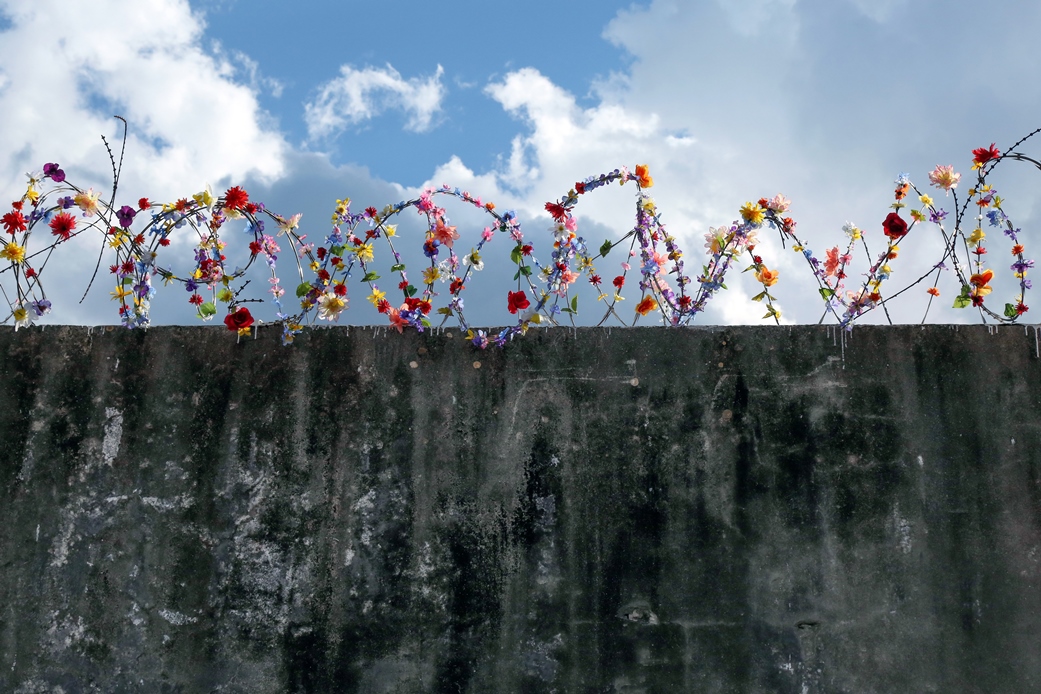Utarand III
2022 - Sculpture (Sculpture)
160.02 x 55.88 cm
Prabhakar Kamble
To produce the series of sculptures collectively titled Utarand , Prabhakar Kamble relocated his studio to Kolhapur, Maharashtra, near the village where he was born into a family of daily wage earners. Kamble cast the feet of agricultural workers in metal to prop up the eponymous terracotta pots traditionally used to store food and grains in every home. A commentary on the caste system’s four-tiered hierarchy, the pots become smaller as they go up the stand, mimicking the structure of society where most of the population is comprised of impoverished communities, which form the base of the caste system while a small minority makes up the wealthy upper castes. The pots also resemble the terracotta urns that traditionally contain ashes, illustrating the violence of caste conflict lynchings. Atop each structure is a symbol of dehumanization; Utarand III features a street sweeper’s broom painted in indigo, the color that the Ambedkarite community associates with emancipation and abolishment of castes.
Prabhakar Kamble is an artist, curator, and cultural activist. His work addresses social justice, the annihilation of caste, and the denial of these issues by institutions due to selective humanism and ruling class aesthetics negating subaltern expression. His practice is informed by Ambedkarite principles that privilege equality over caste identity. He is known for his politically-engaged performances, which are often complex commentaries on society, marked by a symbolic use of material, either found or made and at times heightened by the representation of a color.
Colors:
Related works sharing similar palette

© » KADIST
Douglas Gordon
2002Blind Spencer is part of the series “Blind Stars” including hundreds of works in which the artist cut out the eyes of Hollywood stars, in a symbolically violent manner...

© » KADIST
Paul McCarthy
2010To make Mickey Mouse (2010), Paul McCarthy altered a found photograph—not of the iconic cartoon, but of a man costumed as Mickey...

© » KADIST
Martin Kippenberger
19897″ Single ‘Pop In’ by Martin Kippenbergher consisting of a vinyl record and a unique artwork drawn by the artist on the record’s sleeve...

© » KADIST
Oded Hirsch
2012Oded Hirsch’s video work Nothing New (2012) utilizes seemingly absurdist tropes to raise more trenchant questions about communal action and collective identity in modern day Israel...

© » ARTS EQUATOR
Weekly Picks: Malaysia (12–18 Nov 2018) | ArtsEquator Thinking and Talking about Arts and Culture in Southeast Asia Weekly To Do November 12, 2018 Bisikan Monsoon — Open Rehearsal , at Selangor & KL Kwang Tung Association, 13 Nov, 5:30pm An invitation to view the rehearsals for Kwang Tung Dance Company’s Bisikan Monsoon (the show is travelling to China later in the month)...

© » KADIST
Ahmet Ögüt
2022Monuments of the Disclosed by Ahmet Ögüt is an NFT series of digital monuments to whistleblowers...

© » LENS CULTURE
Whispers - Photographs by Yuanbo Chen | Text by Magali Duzant | LensCulture Feature Whispers A multi-layered approach to visual storytelling — a conversation, a portrait, and a detail of a personal object or a place — captures the shared experiences of Chinese citizens coping with isolation while abroad during the Covid lockdown...

© » LENS CULTURE
Articles of Virtu - Photographs by Bryan Birks | Text by Magali Duzant | LensCulture Award winner Articles of Virtu Prized old automobiles—that most American of obsessions—are the entry point to the surprising beauty and tenderness of their owners, the communities they belong to, and the aspirations they hold dear...

© » KADIST
Roman Ondak
2003As the caption purposely admits, these drawings were made by friends of Ondák’s at home in Slovakia asked to interpret places he has journeyed to...

© » KADIST
Clemens von Wedemeyer
2003Silberhöhe , directed at Halle, located in the former GDR (German Democratic Republic), is the name of a neighborhood on the outskirts of the city, which was built in the 70’s and could accommodate more 40,000 people...








/cdn.vox-cdn.com/uploads/chorus_asset/file/22496659/ss_856dc0a7fdf8bffb04cff24a3c9176e628879ff5.jpg)

